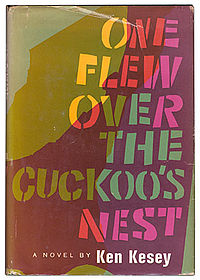
As I mentioned last time, I have found useful writing tips to be few and far between. This is, to me, one of the most powerful things you can use in creating fiction, but it’s subtle and has no real nuts/bolts application. But just being aware of it helps you when nothing else does. The term is “narrative voice”.
I first heard it in school from Jack Cady, a very talented short story writer who taught writing and science fiction in the Engineering department. Oddly, two weeks later I was sitting in a bar just off campus with Ken Kesey, and he said exactly the same thing. So I took it to heart.
It’s a vague and slippery concept as writing tips go, closer to psychology or spirituality than to medicine or exercise. But you should be aware of it: just keep that awareness a little unfocused. Narrative voice is, in Cady’s words, the way your story wants to tell itself. It’s way more than a point of view or style or dialect or mode or any of that, though all of those are elements in it. You pick up a children’s book about a kid looking for a lost friend and read it, it’s telling itself in a certain way that fits the story. Then you pick up a noir detective story about a guy looking for a lost friend and it tells itself in a very different way.
Sometimes you see satires or fun stories that switch the narrative voice. Black Beauty as told by Mike Hammer, a sexy romance in the cadences of the King James Bible, whatever. And it makes you aware of that voice that lies below the various elements that are more often described and debated. You don’t decide, “Well, I guess I should use limited third person, and maybe take the POV of the detective’s sidekick.” Those flow out of the proper narrative voice, each element determining the others. And it makes all the difference. I would say that you can spin your wheels and pound your brow for a long time until the right narrative voice makes itself felt, and when it does, the thing just starts telling itself.
 Which is exactly what Kesey said. He mentioned “One Flew Over the Cuckoo’s Nest”, which at one point was just driving him nuts. He was trying different POV’s, different perspectives and techniques, all the stuff he learned at Stanford, and beginning to despair of getting a handle on what is a much trickier story than it looks. Then, from out of nowhere, he came up with The Chief. A catatonic Indian who stands motionless in the psych ward, watching what goes on. And when he hit that, he told me, everything fell into place and the writing just took off, dragging him along behind it.
Which is exactly what Kesey said. He mentioned “One Flew Over the Cuckoo’s Nest”, which at one point was just driving him nuts. He was trying different POV’s, different perspectives and techniques, all the stuff he learned at Stanford, and beginning to despair of getting a handle on what is a much trickier story than it looks. Then, from out of nowhere, he came up with The Chief. A catatonic Indian who stands motionless in the psych ward, watching what goes on. And when he hit that, he told me, everything fell into place and the writing just took off, dragging him along behind it.
I’ve mentioned this to a lot of writers, the majority of whom have never heard the term–because people don’t teach what they can’t understand or break down into rules and nomenclature–and the majority grasped it immediately. Yeah, yeah… I was going nowhere until I realize the little girl was sitting there watching all of it. Yeah, it was just one more hack mystery until I started hearing it from the driver, looking back twenty years later, sneering at their fake tough attitudes when they were kids.
I’m not talking about something like the idiot online advice I saw the other day: to tell the story from the dog’s point of view. The voice might be a totally dry, disembodied narrator. It might be something as intricate as the gradually aging narration in Joyce’s “Portrait Of The Artist”. But your designated narrator is there, speaking a certain way, and when you hear it, it will be couched in the POV and voicing and mood and attitude that you need to get the thing done.
Trouble is, this is where I should be saying, So here’s how you go about identifying and implementing the Narrative Voice. And there ain’t any. Sorry.
So what good is all this? Because just being aware of something subtle very frequently helps you be receptive to it. It’s like believing there is intelligence behind the universe or that you have a soulmate somewhere. As long as you think you can learn some more esoteric POV label to help you, you’ll stumble in the dark. But if you know what is actually happening–that you are moving things around and listening to the story, waiting to hear its voice–then you can save a lot of time and stress getting there.
I often find that when I first think of a story it comes to me in very dry chunks. What if there’s this guy who thinks his son’s dead, but he really isn’t. And, oh, wait, the son isn’t even really his son. Blunt third person scratch notes. But at some point the plot and characters are known and the restless mind starts speaking in the voice of the story, the stuff you write down as part of the writing process. The more you know there is a voice hidden in there to tell you the tale, just as the sculptor knows there is a dolphin hidden inside that block of marble, then you can move towards it, calmly welcoming the true voice by which your story wants to be told.
* * * * *
Lin Robinson is the author of several books and manuals, available at Amazon. An award-winning journalist and magazine/catalog guru in his mis-spent youth, he now lives in Mexico and doesn’t even drink much. You can learn more about Lin at his website. You can also follow him on LinkedIn and Twitter. [subscribe2]

You sat in a bar with Ken Kesey? Color me green.
The Blue Moon in Seattle. One of those places where everybody shows up eventually. I've talked to Gary Snider there, Manhattan Transfer, Tom Robbins… quite a place.
Or was, maybe
Tom Robbins? Now I'm insanely jealous.
Interesting article, Lin. Love Kesey saying the story dragged him along behind it.
Never had a label for it but I know exactly what you mean. That's why I disagreed so strongly when an acclaimed author who read the first 15 pages of my second book told me to use current dialogue patterns in my old world style fantasy. Actually two of them said the same thing. But changing the tone or style of my dialogue and even the description and narrative parts would have altered the entire feel or tone of the book. I knew in my gut they were wrong. And they were.
great advice!
I think the only practical advice I've heard along these lines is, "If the narrative's not working, try changing your PoV character." But you're right, Lin, finding the story's narrative voice is usually a much less cerebral undertaking. Good stuff.
Good post. Paul Auster and I might disagree about the dog's POV – Timbuktu is a rather good book. Good points, all.
Oh, I don't doubt a dog point of view could work very well. I just got one I'm dying to get to. Jack London sure did it up great: Buck was one of my childhood heroes.
But as an exercise, I think it lacks a certain general usefulness.
Oh god, Lin, you're either gonna love or loathe my next post.
Interestingly, the movie version of Cuckoo's Nest dispensed with the Chief perspective and yet it still worked… for the movie.
Hadn't thought of that, but you're right. Thing is, in a film, you're there. There's no need for a narrator.
Thanks Lin. You've put into words a feeling I couldn't name. That story about Ken Kesey clinched it. Now if only find that voice were just a little bit easier.
What happens if you lose the voice?
Learn sign language.
Then you can show, not tell. 🙂
Lovely post, Lin!
I literally just wrote a blog post about pov yesterday. I've always gravitated to multiple points of view. I like knowing what the characters feel and what is in their heads. I have recently learned the worh of sticking in one head for the duration of a scene, but sometimes I still have to switch when a character keeps yelling at me to be heard. I think it would be difficult for me to tell a story all from one character's perspective. I never really have one main character. I may focus in on a couple but I usually have a group of main characters who are all equally important.
I never heard the term before, but it makes sense; far more sense than what I stammer when trying to explain how the story "writes" itself. Thank you.
This makes perfect sense, even if it can't be quantified or tied down to bullet points. I was struggling with a book that I was telling from the female protagonist's POV and it was like slogging thru mud. One day it dawned on me that I really needed to tell the story from the POV of the maybe-gay-maybe-not academic and it felt like everything just opened up. And, as always with creative arts, this is not something that can be taught or learned mechanically. It must be felt and understood in a deep, organic way. This is the kind of thing many people spend thousands of dollars trying to learn–and it's free!
Funny – I don't see a narrative voice until I name the character. I pour through naming books and come up with something (first and last name) that would describe characteristics of this character. And then I start to hear someone telling a story.
You never what will peg it down.
I like pictures of characters, by the way. Hunt them up on the net. I'm totally in love with about 4 or my gals.
Thanks, Lin! Great way to describe an elusive concept.